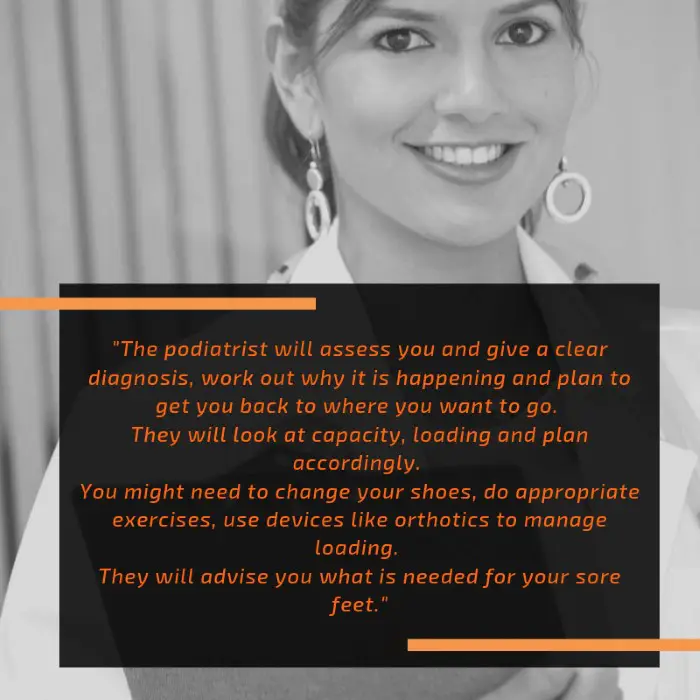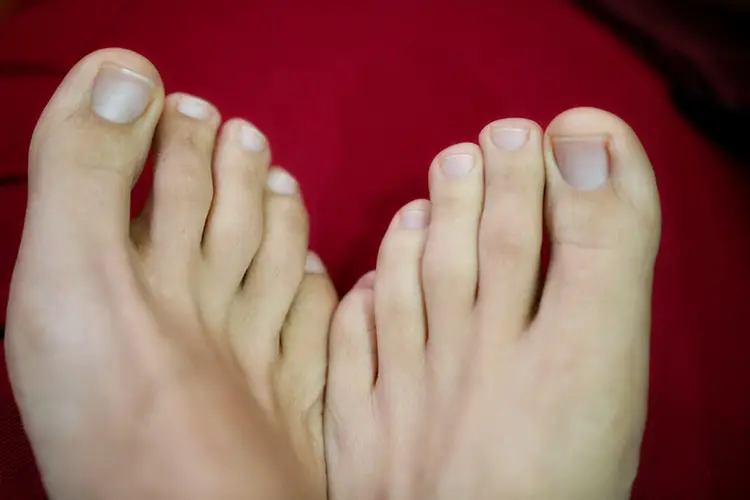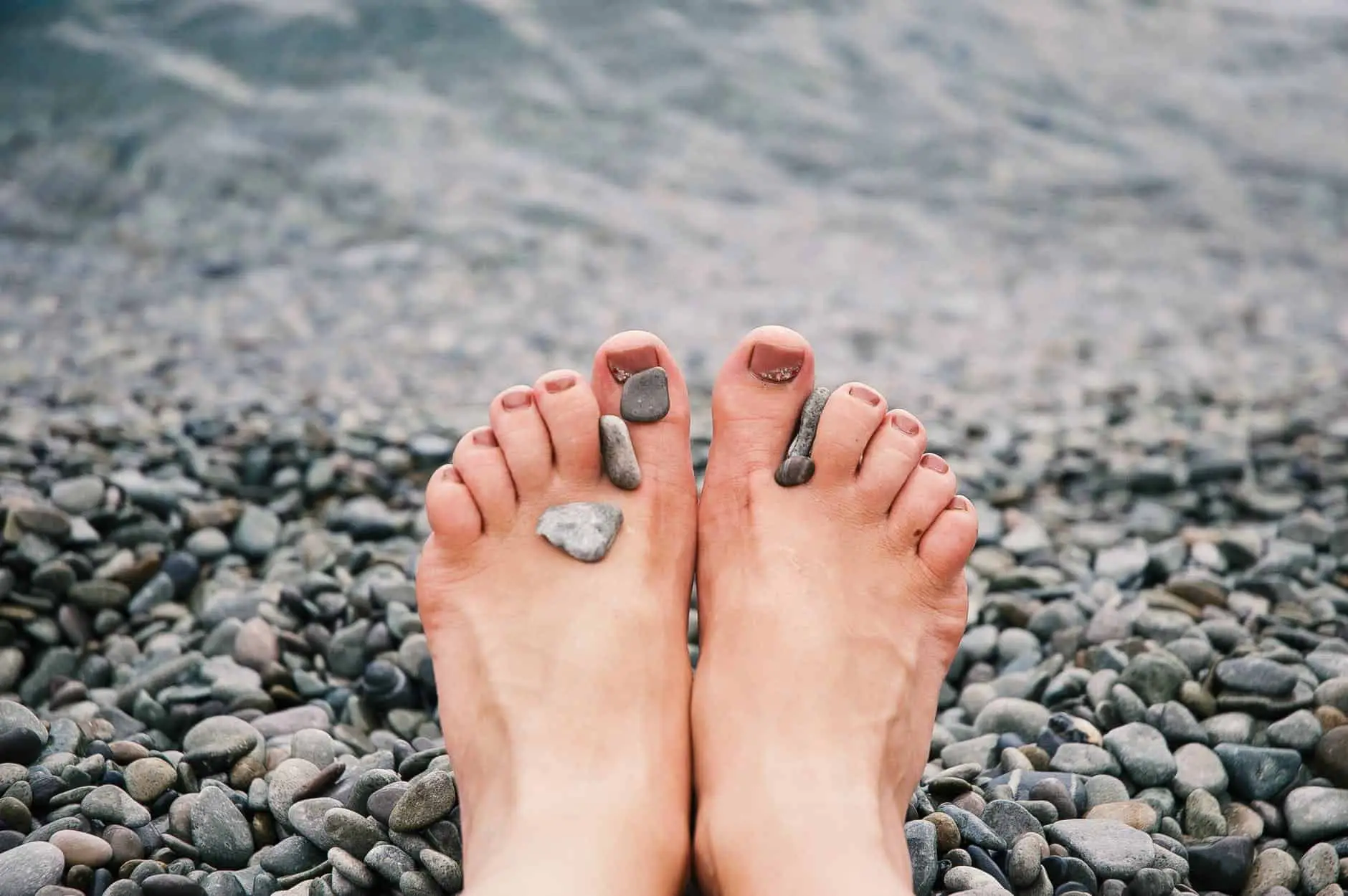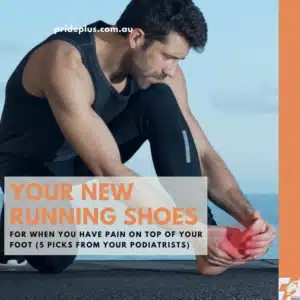Sesamoiditis
What is Sesamoiditis?
Sesamoiditis is an overuse injury in which prolonged, high impact forefoot loading causes irritation and subsequent inflammation of the peritendinous structures in which the sesamoid bones are located.
In other words, a sore big toe joint.
The reasons why this overuse occurs can range from particular gait patterns during high impact activity to poor footwear choices.
The exact reasons for your Sesamoiditis must be determined via a thorough clinical assessment from a skilled podiatrist.
Sesamoiditis Symptoms
Typically pain is localised to the underside of the big toe joint but can often radiate throughout the entire great toe joint.
Symptoms are often worse on weight bearing, particularly activities that place the big toe joint in an extended position (such as a plank or lunge position). Explosive weight-bearing activities can further exacerbate symptoms (jumping, hopping, running).
What To Do
If you have a sore big toe joint or suffering with Sesamoiditis, it’s best to see a podiatrist ASAP.
If you’re a fellow health professional with a client that you suspect has Sesamoiditis then refer them over to a podiatrist.
Delaying therapy can lead to risks relating to further damage and persistent pain. Being a chronic overuse injury, if the causative overload is not redirected away from the sesamoid, the risk of stress fracture or avascular necrosis development is heightened.
Whilst awaiting a podiatry assessment, symptom guidance can be advised. As the reason(s) for developing Sesamoiditis are specific to each case, not everyone will respond in the same manner.
Some general therapeutic advice that is unlikely to cause harm and potentially be beneficial for Sesamoiditis is:
- Education: Pain education, reassurance, avoidance of nocebic language.
- NSAIDS topically (Voltaren Gel). You can trial oral NSAID’s also if safe to do so
- Avoid exercise that places the big toe under increased pressure (such as a plank, push up or lunge position).
- Wear the shoes you feel MORE comfortable in
- Footwear can increase or decrease sesamoid loading (even runners can inc/dec loads)
- Refer to a podiatrist
For referrers we find that the following explanation works best:

What Not To Do
- Wait and delay. With Sesamoiditis if appropriate offloading measures are not implemented in a timely manner, the risk of further injury development is significantly increased.
- Nothing. Sesamoiditis is not a self-limiting condition. Doing nothing is a clinical decision that is related to short/long term harm.
If you’re suffering or your clients have Sesamoiditis - refer them to our expert PridePlus Health podiatry clinics located in Melbourne CBD, Emerald and Pascoe Vale.


Want to Know More? Here's a more in-depth look at Sesamoiditis
What is it?
An irritation of the peritendinous structures surrounding the sesamoids bones of the great toe.
These bones are contained within the Flexor Hallucis Brevis tendon as well as a portion of the plantar plate.
The medial or tibial sesamoid is typically more prone to injury as compared to the lateral or fibular sesamoid due to its smaller size and more central location under the 1st metatarsal head (Atiya et al).
The sesamoid’s function is to stabilise the first ray, increase mechanical advantage during propulsion as well as protect the 1st metatarsal head by dispersing direct compressional force.
When a person is standing in a static position, the sesamoids reside proximal to the 1st MTPJ. As the first ray dorsiflexes, during the propulsive phase of gait, the sesamoids move distally to act as the main weight bearing focus under the 1st MTPJ.
This results in as much as 300% bodyweight force being transmitted through the sesamoids during high impact activity such as running.
Chronic, repeated stress causes compressive forces between the sesamoid and metatarsal head and is further contributed by tensile forces from vigorous, high impact forefoot loading; resulting in sesamoiditis.
Presenting Symptoms
- Typically painful and sharp.
- Patients generally present with insidious onset activity-related medial forefoot pain, that eases on rest.
- Pain is exacerbated by weight bearing and upon dorsiflexion of the 1st MTPJ.
- Most patients will describe acute/severe pain on the propulsive phase of gait, and will typically load the lateral column of the foot to avoid weight bearing over the 1st MTPJ.
- Further symptoms will typically include a restricted and painful range of motion at the 1st MTPJ
- Tenderness upon direct compression of the affected sesamoid and reduced plantar flexion strength at the 1st MTPJ.
- In chronic cases, a callus may be present underlying the 1st MTPJ and a burning pain may remain on rest from weight-bearing activity.
- Nocturnal pain should not be apparent in most cases. If this presents, it is important to rule out the possibility of a stress fracture of the sesamoid or metatarsal head.
Myths, falsehoods and quarter truths
Myth 1: A cortisone injection will fix it
Mostly, no. Although the anti-inflammatory effect may be beneficial in the short term for pain management, it is important to consider that this is an overuse condition due to repetitive focal stress.
Without biomechanical modification of loading distribution, it is likely that this condition will further degenerate.
Furthermore, a cortisone injection should not be administered in the presence of a stress fracture or avascular necrosis, so it is important to ensure that the condition has not yet progressed to this stage (Sims & Kurup).
Myth 2: A CAM boot is required
In most cases, no. Although the offloading achieved via a CAM boot will ease painful symptoms in the short-term unless biomechanics are addressed it is likely that the condition will return upon return to normal activity.
Furthermore, the muscular deconditioning from the global offloading of a CAM boot can further add to focal forefoot loading.
Necessary force redistribution can be achieved whilst keeping the patient active and engaged with their injury management plan.
Myth 3: You cannot wear high heels anymore
Although it is true that an increased heel height can in turn increase forefoot loading, it is not necessary to rule out high heels forever.
Sesamoiditis is largely seen within a younger active female population: significantly limiting footwear options may negatively impact their buy-in to the overall treatment plan (Waldman).
Instead, it may be beneficial to discuss low-heeled supportive footwear options as an interim treatment method and then look to load modifications, via the help of a podiatrist, in the future so that high heeled shoes can remain a regular fashion choice.
Treatment Options
As it is an overload on the sesamoid bones, doing less, in theory, could be an option. However reducing physical activity by doing less is not a good one.
Doing less on our feet has significant deleterious effects on our health, mood, lifestyle and sporting performance.
For Sesamoiditis, treatment should focus on three aspects. Load optimisation, capacity building and education.
Load optimisation is where we work out what loading is essential and what is potentially pathological.
The main focus for the sesamoids is to encourage soft tissue recruitment and activation to reduce focal compression on the bone itself as well as the non-contractile tissues that surround it.
We do this via:
- Footwear
- Strapping
- Padding
- Orthotics
- Gait Training (for runners)
Capacity building is taking the fixed capacity of work that the surrounding musculature and sesamoid bones are currently doing, and then increasing it.
Education here really means pain education.
Recognising the powerful danger messages and safety messages that our brain interprets relating to sesamoid pain is a really powerful way of taking charge of your own Sesamoiditis symptoms.
Pain education around Sesamoiditis can not only decrease painful symptoms themselves, it can lead to improved decisions around managing Sesamoiditis factors in the future as well.
We also take the time to explain to every client the exact reason for their Sesamoiditis, their symptoms and allow opportunities for discussion and questions. This leads to the critical step of goal setting.
When treating painful Sesamoiditis there’s also the 5% ‘ers. They can include pain modulation with anti-inflammatories, massage, heat and icing..
Goal Setting
For Sesamoiditis goal setting is such an overlooked yet critical aspect of health care, actually asking what our clients want and why they want it.
A client suffering from Sesamoiditis symptoms for only a short period of time vs. those with chronic symptoms will have different goals and expectations.
Goal setting in the short, medium and long term provides a useful framework to fall back on when compliance/adherence or life gets in the way of best-made plans to manage painful Sesamoiditis.
Resources:
1. Sesamoiditis of the metatarsophalangeal joint. OA Orthopaedics (2013). Atiya S, Quah C, Pillai A.
2. Painful sesamoid of the great toe. World Journal of Orthopaedics (2014). Sims A, Kurup H.
3. Sesamoiditis. World Atlas of Uncommon Pain Syndromes (2014). Waldman S.



